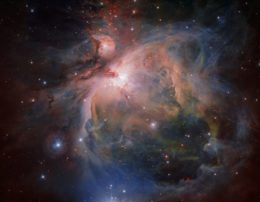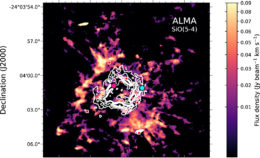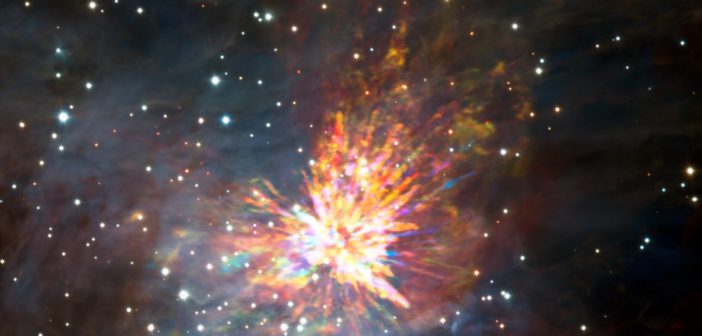There’s still much we don’t know about the birth of massive stars — stars with more than 8 times the mass of the Sun. A recent study reveals details of a thousand-year-old explosion that might provide clues about the formation of these giants.
An Unexpected Explosion

The clouds of molecular gas in regions like the Orion nebula provide nurseries in which massive stars form and evolve. [ESO/G. Beccari]
This one-off discovery was intriguing. One could imagine a number of sudden, energy-liberating events that could occur in a massive star-forming environment — like the formation of a close massive stellar binary, or the merger of two young, massive protostars. And the discovery of several candidate runaway stars at the fringes of the explosion provided another hint to a dynamical origin.
Could this explosion help us understand the process of how massive stars form in their birth environments? Or was it just a fluke event? As years passed without astronomers finding evidence of another, similar outflow, these questions remained unanswered.

This ALMA SiO map of the star-forming region G5.89 shows outflowing molecular gas surrounding an expanding, shell-like HII region (white contours). Two stars moving away from the origin are marked in magenta and cyan. [Adapted from Zapata et al. 2020]
Two of a Kind
Forty years later, we now have proof of another such explosive outflow in a massive star-forming environment. In a recent publication led by Luis Zapata (UNAM Radio Astronomy and Astrophysics Institute, Mexico), a team of scientists has used the Atacama Large Millimeter/submillimeter Array (ALMA) to confirm the presence of streamers of molecular gas flowing isotropically outward from a central point in the massive stellar birthplace G5.89, which lies roughly 10,000 light-years away from us.
Zapata and collaborators measured 34 molecular filaments in this explosive outflow, finding that the streamers are accelerating as they expand outward. This is consistent with behavior of the Orion explosion and shows that the density of the ejecta is substantially larger than the surrounding medium.
As with the Orion explosive outflow, the point of origin of the filaments contains no source. Previous studies, however, have identified several young, massive stars in the periphery of the G5.89 explosion that are speeding away from the point of origin at roughly the right speed to have been at the center 1,000 years previously at the time of explosion.
Learning about Stellar Birth

A protostar lies embedded in a disk of gas and dust in this visualization. The collision of two protostars could release enough energy to power an explosive molecular outflow — and produce a massive star. [NASA’s Goddard SFC]
The authors estimate a rate for such outflows based on our limited observations, finding that there should be one every ~100 years. The fact that this is very close to the rate of supernovae further solidifies the connection of explosive molecular outflows to massive star formation.
Dedicated, high-sensitivity searches for more such outflows in nearby massive star-forming regions will certainly go a long way toward confirming this theory. In the meantime, the authors argue, we should consider revising high-mass star formation models to include dynamical interactions, as these stellar explosions may prove to be regular occurrences!
Bonus
The animation below shows a different view of the authors’ ALMA-observed streamers, traced by CO gas. Two axes give the position of observations, while the third axis and the colors show the radial velocity at each point in the streamers, showing how the ejecta are accelerating as they expand outward. The star marks the origin of the explosive outflow.
Citation
“Confirming the Explosive Outflow in G5.89 with ALMA,” Luis A. Zapata et al 2020 ApJL 902 L47. doi:10.3847/2041-8213/abbd3f


3 Comments
Pingback: From AAS NOVA: “A Map of a Stellar Explosion” | sciencesprings
Pingback: A Map of a Stellar Explosion – Sky & Telescope – §Framework Info§
Pingback: A Map of a Stellar Explosion - Sky & Telescope – TheLife247